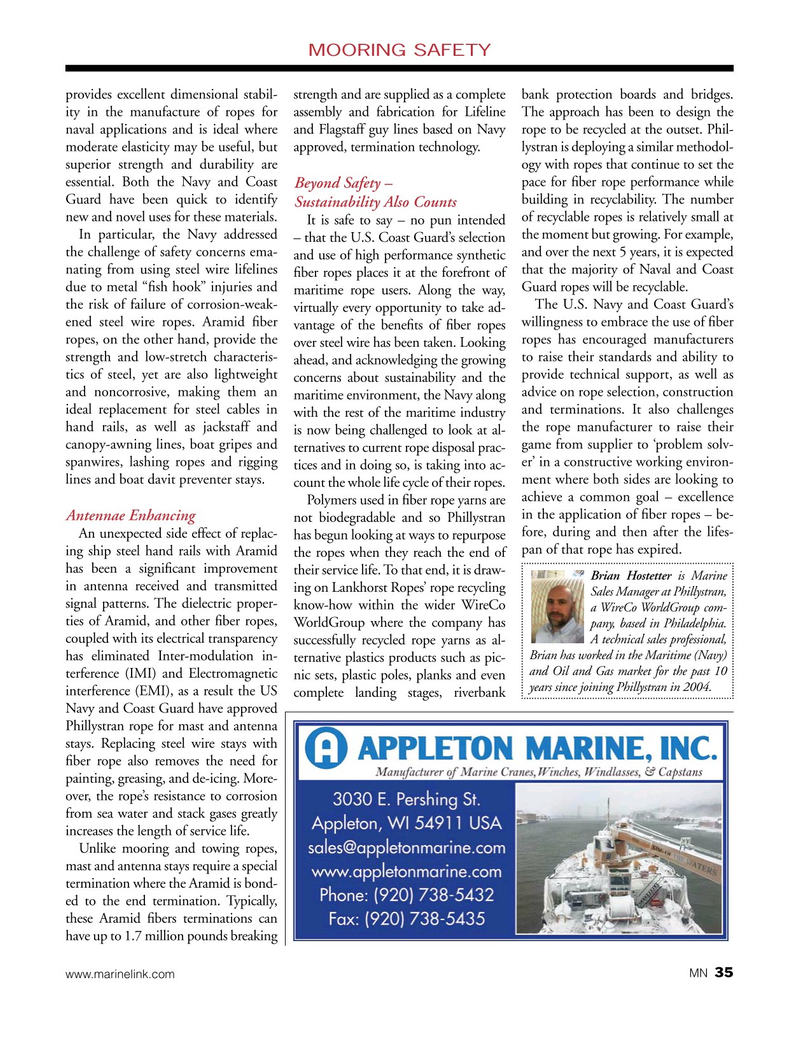
Page 35: of Marine News Magazine (February 2019)
Dredging & Marine Construction
Read this page in Pdf, Flash or Html5 edition of February 2019 Marine News Magazine
MOORING SAFETY provides excellent dimensional stabil- strength and are supplied as a complete bank protection boards and bridges. ity in the manufacture of ropes for assembly and fabrication for Lifeline The approach has been to design the naval applications and is ideal where and Flagstaff guy lines based on Navy rope to be recycled at the outset. Phil- moderate elasticity may be useful, but approved, termination technology. lystran is deploying a similar methodol- superior strength and durability are ogy with ropes that continue to set the essential. Both the Navy and Coast pace for fber rope performance while
Beyond Safety –
Guard have been quick to identify building in recyclability. The number
Sustainability Also Counts new and novel uses for these materials. It is safe to say – no pun intended of recyclable ropes is relatively small at
In particular, the Navy addressed – that the U.S. Coast Guard’s selection the moment but growing. For example, the challenge of safety concerns ema- and use of high performance synthetic and over the next 5 years, it is expected nating from using steel wire lifelines fber ropes places it at the forefront of that the majority of Naval and Coast due to metal “fsh hook” injuries and maritime rope users. Along the way, Guard ropes will be recyclable.
the risk of failure of corrosion-weak- The U.S. Navy and Coast Guard’s virtually every opportunity to take ad- ened steel wire ropes. Aramid fber vantage of the benefts of fber ropes willingness to embrace the use of fber ropes, on the other hand, provide the over steel wire has been taken. Looking ropes has encouraged manufacturers strength and low-stretch characteris- ahead, and acknowledging the growing to raise their standards and ability to tics of steel, yet are also lightweight concerns about sustainability and the provide technical support, as well as and noncorrosive, making them an maritime environment, the Navy along advice on rope selection, construction ideal replacement for steel cables in with the rest of the maritime industry and terminations. It also challenges hand rails, as well as jackstaff and is now being challenged to look at al- the rope manufacturer to raise their canopy-awning lines, boat gripes and ternatives to current rope disposal prac- game from supplier to ‘problem solv- spanwires, lashing ropes and rigging tices and in doing so, is taking into ac- er’ in a constructive working environ- lines and boat davit preventer stays. count the whole life cycle of their ropes. ment where both sides are looking to
Polymers used in fber rope yarns are achieve a common goal – excellence
Antennae Enhancing not biodegradable and so Phillystran in the application of fber ropes – be-
An unexpected side effect of replac- has begun looking at ways to repurpose fore, during and then after the lifes- ing ship steel hand rails with Aramid the ropes when they reach the end of pan of that rope has expired. has been a signifcant improvement their service life. To that end, it is draw-
Brian Hostetter is Marine in antenna received and transmitted ing on Lankhorst Ropes’ rope recycling
Sales Manager at Phillystran, signal patterns. The dielectric proper- know-how within the wider WireCo a WireCo WorldGroup com- ties of Aramid, and other fber ropes, WorldGroup where the company has pany, based in Philadelphia. coupled with its electrical transparency successfully recycled rope yarns as al-
A technical sales professional,
Brian has worked in the Maritime (Navy) has eliminated Inter-modulation in- ternative plastics products such as pic- and Oil and Gas market for the past 10 terference (IMI) and Electromagnetic nic sets, plastic poles, planks and even years since joining Phillystran in 2004.
interference (EMI), as a result the US complete landing stages, riverbank
Navy and Coast Guard have approved
Phillystran rope for mast and antenna stays. Replacing steel wire stays with fber rope also removes the need for painting, greasing, and de-icing. More- over, the rope’s resistance to corrosion from sea water and stack gases greatly increases the length of service life.
Unlike mooring and towing ropes, mast and antenna stays require a special termination where the Aramid is bond- ed to the end termination. Typically, these Aramid fbers terminations can have up to 1.7 million pounds breaking 35 www.marinelink.com MN

 34
34

 36
36
